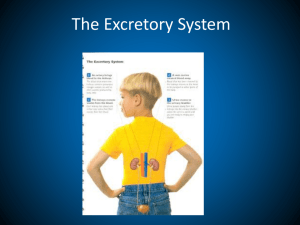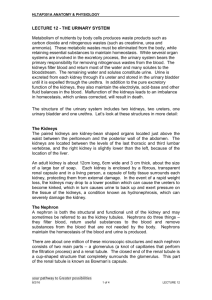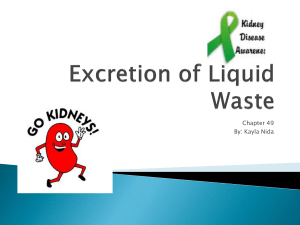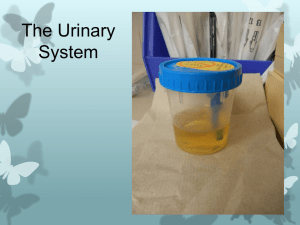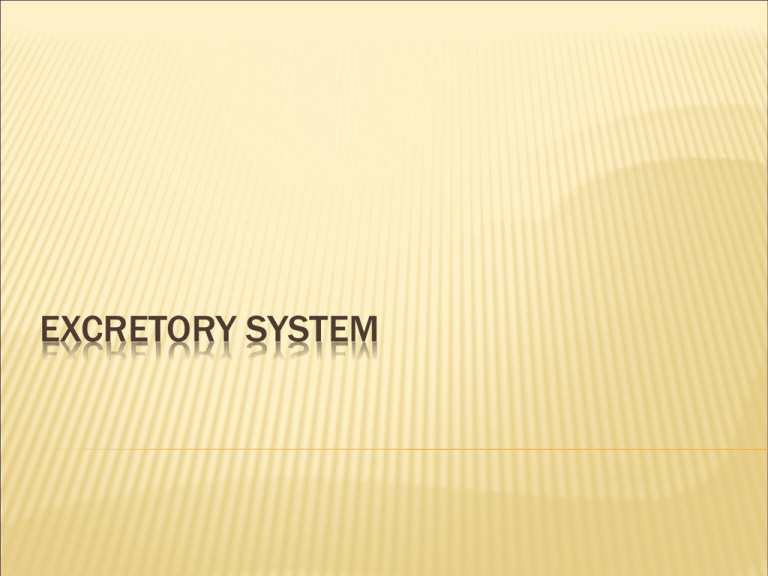
EXCRETORY SYSTEM
Regulate the chemical composition of body fluids by
removing metabolic wastes and retaining the proper
amounts of water, salts, and nutrients.
Components of this system in vertebrates liver,
lungs,
skin.
the kidneys-urinary system
Liver is involved in detoxification of toxic materials that
are consumed by animals while lungs remove carbon
dioxide and the skin removes excess water and salt
through sweating.
THE URINARY SYSTEM
Consists of:
Two kidneys,
Two ureters
A urinary Bladder
The Urethra
THE KIDNEYS
Vertebrates have paired kidneys
Located in the dorsal part of abdominal cavity ventral
to lumber vertebrae.
In most animals right kidney slightly cranial to left.
In ruminants left kidney is loosely attached to the
body wall as it is pushed to right side when rumen
gets filled.
Kidneys regulate body fluid levels primarily
and remove wastes as a secondary one.
FUNCTIONS:
Maintain volume of extracellular fluid
Maintain ionic balance in extracellular fluid
Regulate pH and osmotic concentration
of extracellular fluid.
Excrete metabolic waste as urea, ammonia, uric acid
URINARY SYSTEM
Kidneys
Blood vessel
Ureter
Urinary bladder
Urethra
ANATOMY OF KIDNEYS
Medial border of the kidney is concave and has depressionHilus
-arteries and nerves enter
- the ureters, lymphatics,veins leave kidneys.
Renal pelvis, -Origin of ureter inside kidney, which is expanded receives urine from collecting tubules.
Medulla- Part of kidney surrounding the renal pelvis.
Cortex-the outer part surrounding the medulla.
Glomeruli, proximal and distal convoluted tubules are located in
medulla.
The outer most layer covering the kidney is made up of thin
connective tissue called renal capsule.
Kidney identification
Bovine kidneys:
Bean shape
Lobulated-distinct lobules, visible externally.
Multiple pappilae.
Equine kidneys
smooth without lobulations.
right bean shaped
left - heart shaped
Pigs Long and narrow
bean shaped
smooth externally but lobulated internally.
Multiple papillae when cut.
Sheep, goat, dog, cat- bean shaped, smooth
without lobulations.
The Nephron
Is the functional unit of urinary system
Consists of
1. Cup-shaped capsule -Bowman’s capsule
2.
Glomerulus- capillary tuft.
3. Together they are called-renal corpuscle.
4. Renal tubule.
The tubule is divided into proximal and distal convoluted
tubule, descending and ascending limbs that form loop
of Henle.
The tubule finally joins collecting duct to empty urine into
renal pelvis.
URINE PRODUCTION
Three steps in the production of urine in the kidneys
1) glomerular filtration, 2) Tubular reabsorption and 3)
tubular secretion.
1.Glomerular filtration
The first step
Occurs at the glomerulus-a ball of capillaries that makes
close contact with the end of the nephron.
Driven by the beating of the heart, blood plasma (the fluid
component of blood) is forced out of the capillaries and
into the Bowman’s capsule., the Larger molecules mainly
proteins and blood cells cannot pass.
Glucose, urea, creatinine, Na, K,Cl passses through.
Clinical importance- Proteinuria, haematuria
2. Tubular reabsorption
Large part of urine production involves removing
filtrate for delivery back to the blood-reabsorption, is
highly selective.
Cells in the proximal and distal convoluted tubules
actively absorb nutrients out of the filtrate- help of
microvilli seen in the lumen of tubules.
Reabsorption of water as well- osmosis.
Sodium ion, glucose, amono acids and other nutrients
are also reabsorbed into the blood from the filtrate.
(Diabetes-glucosuria)
3. Tubular secretion
At the same time, other cells in the proximal
and distal tubules are engaged in secretion.
This process involves active transport of
specific molecules into the filtrate.
An example of a commonly secreted substance
is hydrogen ions, potassium ions, ammonium
ions, creatinine and urea.
Finally, the tubule empties its contents into one of the
many collecting ducts.
The urine now contains a concentrated solution of
whatever the body currently considers being "wastes."
Water continues to be reabsorbed in the collecting duct,
so that little water is wasted in the process of excretion.
Finally, all the urine collects together in the kidney and
is passed out through the ureter, and from there to the
bladder.
When the bladder is filled or enough urine is produced
it is expelled.
MICTURITION
Process of expulsion of urine from bladder.
When the bladder is distended pressure builds
up and it stimulates reflex center in the spinal
cord, which relaxes the smooth muscle
sphincter at the neck of the bladder and
contraction of bladder expelling urine out.
But…reflex emptying of bladder can be
controlled by urethral muscle.
Ureters
Each ureter originates at the renal pelvis.
It is a muscular tube that conveys urine from pelvis
of kidney to the urinary bladder.
The smooth muscle undergoes peristaltic
waves of contraction that brings the urine into
the bladder.
Urinary bladder
Is hollow muscular organ that vary in size and
position with the quantity of urine it contain.
When empty it is thick walled pear shaped and
located on the floor of pelvis.
when filled with urine wall become thin and
displaced towards the abdominal cavity.
Neck of bladder continuous with urethra caudally.
Muscles at the neck of bladder is arranged in
circular manner forming sphincter that regulate
passage of urine into urethra.
Urethra
Is the continuation of neck of bladder.
It is a tubular structure that drains out urine during
micturition.
In male it divided into pelvic and penile urethra while
in female pelvic urethra opens into vagina.
In male pelvic urethra is joined by vas deferens and
ducts from accessory sex glands as well.
CLINICAL TERMS
Nephroectomy- Surgical removal of kidneys
Nephritis-inflammation of kidneys.
Urolithiasis- Presence of stones in the urinary system.
Nephrolith- Stone in the kidneys.
Diuretic- Any substance that increase urine output.
Oligouria- Scanty amount of urine formation.
Polyuria- Excess amount of urine formation.
Dysuria- painful urination.
Enuresis- involuntary urination/bed wetting.
Pyuria- pus in urine
Uninalysis-Microspic examination /analysis of urine.
Cystitis-Inflammation of urinary bladder.
Micturation –urination /voiding of urine. A reflex
action stimulated by distension of bladder. Can be
prevented by voluntary control of urethralis muscles
sorrounding the pelvic urethra.
CLINICAL TERMS
Kidney worms-Dictophyma renale worm in kidneys of
dogs and cats -may damage the kidneys.
Kidney stones formation results from crystallization of
chemical salts like ammonium urate or sodium urate
etc. it may obstruct urethra especially in males.
Nephritis may result either due to infection or
presence of irritants
Ingestion of some plants may cause urinary tract
tumors
Glucosuria (glucose in urine)- Uncontrolled diabetesexcess level of blood glucose-cannot be reabsorbed in
the proximal tubules.
Proteinuria (proteins in urine)- diseases that affects
the glomeruli.
Renal insufficiency- degree or relative loss of renal
function, but the animal can survive its state. Renal
Renal Failure-complete loss of renal tissue function
and the animal can't survive or can't continue its
existence.

